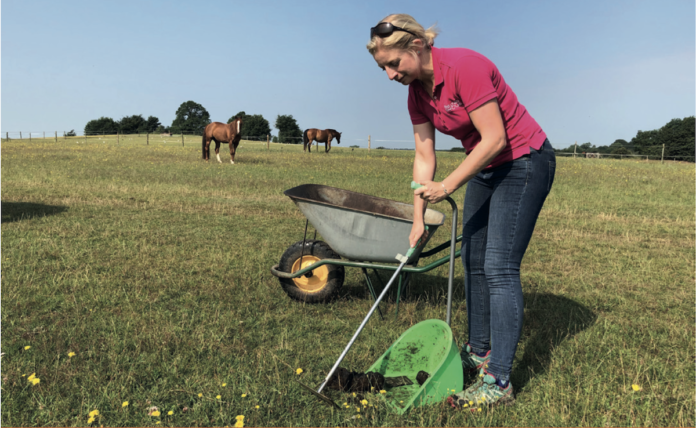
WE ALL KNOW ABOUT TARGETED WORMING PRACTICES. DON’T WE?
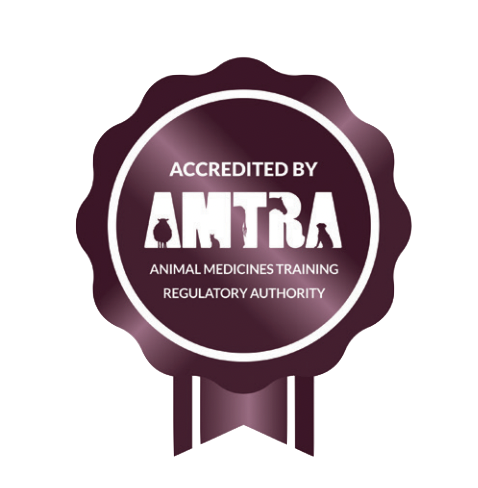
By Claire Shand, RAMA and director of marketing and communications, Westgate Laboratories.
AMTRA is required by the Veterinary Medicines Regulations to ensure its RAMAs/SQPs undertake CPD. All RAMAs/SQPs must earn a certain number of CPD points in a given period of time in order to retain their qualification. RAMAs/SQPs who read this feature and submit correct answers to the questions below will receive three CPD points. For more about AMTRA and becoming a RAMA/SQP, visit www.amtra.org.uk
"In real life, strategy is actually very straightforward. You pick a general direction and implement like hell."
Jack Welch, former CEO of General Electric
Writings for the perils of wormer resistance have been on the wall in UK agriculture since the mid-1980s.
The first messaging specifically aimed at horse owners was developed here by Westgate Labs when we first pioneered our worm egg count service in 1999.
The British Veterinary Association (BVA) put out their first major call to action in 2010 with their ‘Responsible use of Anthelmintics in Grazing Animals’ campaign and there has been a myriad of smaller initiatives in the same vein along the way.
Now in 2022 there’s certainly increased levels of awareness, but still not enough action. Recent research carried out by the British Equine Veterinary Association (BEVA) suggests that UK horse owners give approximately 1.13million doses of wormer annually but carry out only around 120,000 faecal egg counts. That’s just one test for every 11 wormers sold! Multiple surveys show just 10% of owners are testing and treating appropriately.
Despite all we know about the resistance crisis and the environmental damage caused by wormers, far too many people are still blanket dosing without knowledge of which worms they’re targeting, whether the wormer is even necessary and if the given treatment has been effective.
These behaviour stats are scary and should be a real wake up call for the industry. This haphazard approach is putting our horses’ health at risk, both now and into the future.
As RAMAs, our role should be to support horse owners and yard managers with an overarching strategy for parasite control. One that takes into account the age and health status of the horses on the premises and their management to find a solution that makes carrying out best practice parasite control as easy as possible.
GOVERNMENT STEPS IN
If we don’t intervene to change outdated practices it will be within years, rather than decades, that we’ll see all five of our licenced chemicals cease to be effective against common equine parasites. So important is the impending health crisis for horses that the Government’s Veterinary Medicines Directorate (VMD) has stepped in.
An ‘Anthelmintic Resistance Working Group’ of prescribers (vets, pharmacists, RAMAs/SQPs), parasitologists, horse
owners, charities/levy boards, guidance/policy makers, retailers, diagnostics and pharmaceutical industries met in November 2021 and April 2022. As an outcome of this, a core steering group is now being convened by the VMD to discuss and develop the group’s strategy and to develop a pan-industry approach to tackling the problem.
Look out for best practice guidelines and messaging to increase the uptake of diagnostics as just some of the desired outcomes that have been identified.
IN THE NEWS
In tandem, delegates from the VMD, BEVA, Westgate Labs (representing the RAMA perspective) and World Horse Welfare (representing the horse owner perspective) presented at the National Equine Forum in March this year. The session, entitled ‘Equine Anthelmintic Resistance - a collective responsibility’, sought to raise awareness of the severity of the situation within the equine community and the changes needed to address this important topic.
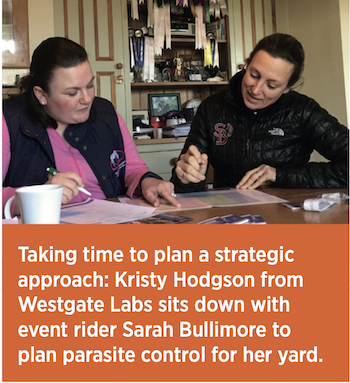
This has been followed up by several hard-hitting news items in equestrian publications such as Horse & Hound and a wave of positive media attention.
Meanwhile the veterinary sector has launched a collaborative campaign supported by BEVA called Project WORMS, which stands for ‘Working to Overcome Resistance and Make for a Sustainable future.’
You may have seen a horse owner survey doing the rounds that is being distributed by veterinary practices. This, they say, is the first stage of a campaign to find out how and when people worm and which products they use. The intention is to use this data to help vets work more closely with horse owners on parasite control.
THE RAMA’S RESPONSIBILITY: USE IT OR LOSE IT
As RAMAs, we absolutely have a seat at the table to influence customer behaviour and we need to step up to take our seats.
Ireland have recently vetoed their SQP structure and are removing these privileges to adopt EU regulation that sees the sale of wormers limited to vets only. In Denmark, proof of the need of a wormer must be shown to buy it, and in Sweden they are available on veterinary prescription only.
Although there are currently no indications that the UK will follow suit, these examples are often cited in the context of prescriber responsibilities and there continues to be high profile opinions being expressed around this topic. As RAMAs, we must redouble our efforts to prescribe responsibly and rebut this pressure.
We must ask ourselves how we can work more effectively with our customers to flip the balance between testing and treatments.
A STRATEGIC APPROACH TO PARASITE CONTROL
The value of having a plan. Do many of your customers follow a proactive parasite control plan or are most of their purchases a more ad hoc buy?
Horse owners are usually busy people and, even with every good intention, the ideal intervals between testing can slip. Many struggle to remember which wormer they gave last and what they were targeting.
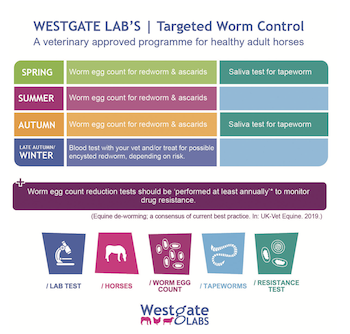
Taking time to create a bespoke outline plan for the year will help to keep them on track and that dialogue open, ultimately leading to a more effective strategy and customer loyalty.
So where do you start? There’s no longer any place for regular chemical worming programmes. The good news is that most healthy adult horses can follow a very simple schedule of testing and targeted dosing. Research shows that using this approach reduces treatments by up to 82%.
Worm egg counts should form the basis of a parasite control programme. Use this table as a basis for your regular schedule of tests, reducing the gap between worm egg counts from 12 to 8 weeks for high-risk horses.
Tapeworm testing can be adjusted to either spring/autumn or summer/winter depending on yard factors. Highlight the need to target encysted redworm once per year, reduction test if any treatments are required and raise awareness of pinworm, bots, lungworm and liver fluke as incidental parasites that may need attention.
The objective is to get an overview of the yard and assess risk with your customer and then devise a testing plan that will enable you to support them with the right chemical selection as and when needed to navigate growing problems of resistance and the need to preserve key medicines.
QUESTIONS TO ASK
What is the age range of horses? Youngsters (under the age of three or four) are more prone to parasite infection as well as being more likely to carry ascarids, parasites to which they usually gain immunity as they mature. Adult horses grazing with them are therefore also likely to be exposed to higher parasite challenge.
The recommended gap between worm egg counts is based on the lifecycle of the small redworm which can go from egg to adult worm within four to five weeks. Advice is to worm egg count young and high-risk horses every eight weeks and healthy adults every 12 weeks.
The likelihood of ascarid infection also affects our choice of chemical if treatment is needed - fenbendazole and pyrantel being good wormers for young horses because of resistance to ivermectin and moxidectin.
In contrast, small redworm resistance to fenbendazole and pyrantel indicates ivermectin and moxidectin better choices for these parasites. It’s a conundrum that makes reduction testing another important part of the plan.
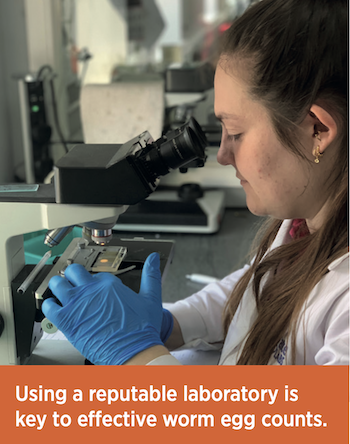
Foals up to six months old should follow a combination of proactive treatment with intermittent testing to monitor efficacy of the programme before they too can move to test-based parasite control.
When were they last wormed and what with? We all need a starting point, and this will give you a line in the sand to work forward from. Generally, we want to test when worming is next due or slightly overdue to ensure that a chemical is not active in the system that would mask results.
Plan a worm egg count 12 weeks after any previous treatment for redworm (eight for youngsters and high-risk horses). An EquiSal tapeworm test should be done every six months – traditionally this has been in spring and autumn but given the increased difficulty in sourcing a praziquantel only wormer, many people find that by testing in late autumn/winter they can combine any treatment needed with their encysted redworm treatment if required.
Will you test or treat for encysted redworm? A blood test is now available through vets that detects encysted stages of small redworm. Adult horses that haven’t needed treatment for redworm through the year based on their worm egg counts are advocated for testing. All other horses are recommended a moxidectin or a 5-day fenbendazole. As our most effective treatment for larval small redworm, moxidectin is a key medicine. We must aim to reserve its use for this purpose and at other times of year revert to ivermectin as an effective treatment for targeting adult redworm stages.
Are there any health issues? Immunity declines naturally as animals age and underlying systemic health conditions can also reduce the body’s resilience to fight infection. Conditions such as PPID (formerly Cushings Disease), Equine Metabolic Syndrome (EMS), laminitis etc can all make horses prone to higher worm burdens. It’s recommended to treat these horses as high risk and worm egg count every eight weeks.
Rescue horses and those who have had a poor start in life can continue to be predisposed to parasite problems throughout their lives, despite the initial problems having been identified and dealt with.
For more sensitive horses and those with histories of colic, you may want to avoid prescribing combination wormers, particularly moxidectin + praziquantel which is two strong chemicals in one. It’s worth noting that although a praziquantel only option is no longer available over the counter, it can be purchased as a Special on POM-V prescription.
Consider advising a probiotic to help the horse assimilate gut disruption caused by the wormer. Recommend that if owners have any health concerns about their animals, they should consult their vet.
Are the horses in good condition? Bodyfat is a particular consideration for giving moxidectin treatment, a chemical that is stored in body fat. Be cautious of prescribing it to underweight horses, and low bodyweight foals, young horses or miniatures that haven’t been accurately weighed. The data sheets advise Equest shouldn’t be given to foals less than four months and Equest Pramox to foals younger than six and a half months old.
Do any of the horses travel away for competitions or training? Busy show grounds and training centres can be hot beds for parasite infection. If horses regularly travel away from home and are allowed to graze around these areas, they are at higher risk of ingesting parasites and bringing these home to infect their herds. They should be classified as high risk and tested more frequently.
What is the horse’s grazing like? Small, stable herds are most advantageous for managing parasite control as they act like closed cells where any high egg shedders can be identified and treated appropriately. New horses should be quarantined and tested to ensure they’re not bringing unwanted visitors.
Poo picking is the most effective way to break the lifecycle of worms mechanically without relying on chemicals. It should be done at least twice a week for optimum parasite control with muck heaps placed more than 3m from the field boundaries to prevent travelling larvae re-entering the field. Is there an opportunity to retail some equipment?
Harrowing in the UK climate is not recommended as it is neither hot nor dry enough to desiccate the dung and expose worm eggs to the UV rays. It simply serves to spread the source of infection further round the field and from the latrine to the lawn areas of the field where horses are more likely to graze.
Pasture should not be overgrazed and rested for at least 3 months between use if possible, to allow redworm eggs and larvae to degrade. Cross grazing with other animals such as sheep, cattle or goats can be advantageous, either at the same time or on rotation. This is because worms are generally species specific and any ingested larvae will not survive in an alternative host, so breaking the lifecycle.
Challenge owners to do what they can to reduce the infection risk on pasture and the need to rely on chemical worm control.
Are there any donkeys or mules on the premises? In line with all equines, BEVA advocate a targeted worm control programme for donkeys based on worm counts and tests.
Be aware of the possibility of lungworm, a parasite that affects donkeys and sometimes mules and that can cause clinical symptoms in horses grazing alongside them.
Ivermectin and moxidectin are the most effective treatments
for lungworm however it is worth noting that neither moxidectin, praziquantel, nor some brands of ivermectin are licenced for treating donkeys so care with dosing should be taken. Mules should be treated in line with advice on donkeys.
Has any reduction testing been done on the premises? Nearly every equestrian property will have resistant parasites, but which worm to which chemical and the level will be highly individual depending on the exposure and types of wormer that have been used.
Going forward, wherever a worm egg count indicates that treatment is required, we should be following up with a reduction test (a second worm egg count) 10-14 days later. This helps us to be confident that a treatment has been effective and enables us to prescribe the most effective treatments.
As you can see there is no one-size-fits-all solution, but we need to find a way through the maze to find practical solutions to increase testing and reduce chemical use, and then ‘implement like hell’ to safeguard horse health both now and into the future.
As RAMAs, we have a key role to play in being part of the solution rather than part of the problem.

ABOUT ETN’S RAMA/SQP FEATURES
ETN’s series of CPD features helps RAMAs (Registered Animal Medicines Advisors/SQPs) earn the CPD (continuing professional development) points they need. The features are accredited by AMTRA, and highlight some of the most important subject areas for RAMAs/ SQPs specialising in equine and companion animal medicine.
AMTRA is required by the Veterinary Medicines Regulations to ensure its RAMAs/SQPs undertake CPD. All RAMAs/SQPs must earn a certain number of CPD points in a given period of time in order to retain their qualification. RAMAs/SQPs who read this feature and submit correct answers to the questions below will receive three CPD points. For more about AMTRA and becoming a RAMA/SQP, visit www.amtra.org.uk










